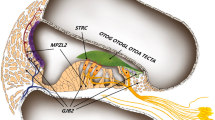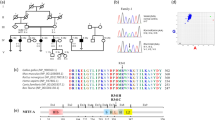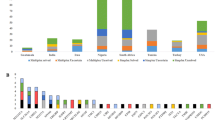Abstract
While recent studies have revealed a substantial portion of the genes underlying human hearing loss, the extensive genetic landscape has not been completely explored. Here, we report a loss-of-function variant (c.72delA) in MPZL2 in three unrelated multiplex families from Turkey and Iran with autosomal recessive nonsyndromic hearing loss. The variant co-segregates with moderate sensorineural hearing loss in all three families. We show a shared haplotype flanking the variant in our families implicating a single founder. While rare in other populations, the allele frequency of the variant is ~ 0.004 in Ashkenazi Jews, suggesting that it may be an important cause of moderate hearing loss in that population. We show that Mpzl2 is expressed in mouse inner ear, and the protein localizes in the auditory inner and outer hair cells, with an asymmetric subcellular localization. We thus present MPZL2 as a novel gene associated with sensorineural hearing loss.


Similar content being viewed by others
References
Abyzov A, Urban AE, Snyder M, Gerstein M (2011) CNVnator: an approach to discover, genotype, and characterize typical and atypical CNVs from family and population genome sequencing. Genome Res 21:974–984. https://doi.org/10.1101/gr.114876.110
Anders S, Pyl PT, Huber W (2015) HTSeq–a Python framework to work with high-throughput sequencing data. Bioinformatics 31:166–169. https://doi.org/10.1093/bioinformatics/btu638
Bacallao K, Monje PV (2015) Requirement of cAMP signaling for Schwann cell differentiation restricts the onset of myelination. PLoS One 10:e0116948. https://doi.org/10.1371/journal.pone.0116948
Bademci G, Foster J 2nd, Mahdieh N, Bonyadi M, Duman D, Cengiz FB, Menendez I, Diaz-Horta O, Shirkavand A, Zeinali S, Subasioglu A, Tokgoz-Yilmaz S, Huesca-Hernandez F, de la L Arenas-Sordo, Dominguez-Aburto M, Hernandez-Zamora J, Montenegro E, Paredes P, Moreta R, Vinueza G, Villegas R, Mendoza-Benitez F, Guo S, Bozan S, Tos N, Incesulu T, Sennaroglu A, Blanton G, Ozturkmen-Akay SH, Yildirim-Baylan H, Tekin M M (2016) Comprehensive analysis via exome sequencing uncovers genetic etiology in autosomal recessive nonsyndromic deafness in a large multiethnic cohort. Genet Med 18:364–371. https://doi.org/10.1038/gim.2015.89
Bowl MR, Simon MM, Ingham NJ, Greenaway S, Santos L, Cater H, Taylor S, Mason J, Kurbatova N, Pearson S, Bower LR, Clary DA, Meziane H, Reilly P, Minowa O, Kelsey L, International Mouse Phenotyping C, Tocchini-Valentini GP, Gao X, Bradley A, Skarnes WC, Moore M, Beaudet AL, Justice MJ, Seavitt J, Dickinson ME, Wurst W, de Angelis MH, Herault Y, Wakana S, Nutter LMJ, Flenniken AM, McKerlie C, Murray SA, Svenson KL, Braun RE, West DB, Lloyd KCK, Adams DJ, White J, Karp N, Flicek P, Smedley D, Meehan TF, Parkinson HE, Teboul LM, Wells S, Steel KP, Mallon AM, Brown SDM (2017) A large scale hearing loss screen reveals an extensive unexplored genetic landscape for auditory dysfunction. Nat Commun 8:886. https://doi.org/10.1038/s41467-017-00595-4
Chen K, Wallis JW, McLellan MD, Larson DE, Kalicki JM, Pohl CS, McGrath SD, Wendl MC, Zhang Q, Locke DP, Shi X, Fulton RS, Ley TJ, Wilson RK, Ding L, Mardis ER (2009) BreakDancer: an algorithm for high-resolution mapping of genomic structural variation. Nat Methods 6:677–681. https://doi.org/10.1038/nmeth.1363
Cukier HN, Kunkle BW, Vardarajan BN, Rolati S, Hamilton-Nelson KL, Kohli MA, Whitehead PL, Dombroski BA, Van Booven D, Lang R, Dykxhoorn DM, Farrer LA, Cuccaro ML, Vance JM, Gilbert JR, Beecham GW, Martin ER, Carney RM, Mayeux R, Schellenberg GD, Byrd GS, Haines JL, Pericak-Vance MA (2016) ABCA7 frameshift deletion associated with Alzheimer disease in African Americans. Alzheimer’s Disease Genetics C Neurol Genet 2:e79. https://doi.org/10.1212/NXG.0000000000000079
DeMonte L, Porcellini S, Tafi E, Sheridan J, Gordon J, Depreter M, Blair N, Panigada M, Sanvito F, Merati B, Albientz A, Barthlott T, Ozmen L, Blackburn CC, Guttinger M (2007) EVA regulates thymic stromal organisation and early thymocyte development. Biochem Biophys Res Commun 356:334–340. https://doi.org/10.1016/j.bbrc.2007.02.131
Dobin A, Davis CA, Schlesinger F, Drenkow J, Zaleski C, Jha S, Batut P, Chaisson M, Gingeras TR (2013) STAR: ultrafast universal RNA-seq aligner. Bioinformatics 29:15–21. https://doi.org/10.1093/bioinformatics/bts635
Guttinger M, Sutti F, Panigada M, Porcellini S, Merati B, Mariani M, Teesalu T, Consalez GG, Grassi F (1998) Epithelial V-like antigen (EVA), a novel member of the immunoglobulin superfamily, expressed in embryonic epithelia with a potential role as homotypic adhesion molecule in thymus histogenesis. J Cell Biol 141:1061–1071
Huang J, Liang X, Xuan Y, Geng C, Li Y, Lu H, Qu S, Mei X, Chen H, Yu T, Sun N, Rao J, Wang J, Zhang W, Chen Y, Liao S, Jiang H, Liu X, Yang Z, Mu F, Gao S (2017) A reference human genome dataset of the BGISEQ-500 sequencer. Gigascience 6:1–9. https://doi.org/10.1093/gigascience/gix024
Iwasaki S, Harada D, Usami S, Nagura M, Takeshita T, Hoshino T (2002) Association of clinical features with mutation of TECTA in a family with autosomal dominant hearing loss. Arch Otolaryngol Head Neck Surg 128:913–917
Kim NK, Kim AR, Park KT, Kim SY, Kim MY, Nam JY, Woo SJ, Oh SH, Park WY, Choi BY (2015) Whole-exome sequencing reveals diverse modes of inheritance in sporadic mild to moderate sensorineural hearing loss in a pediatric population. Genet Med 17:901–911. https://doi.org/10.1038/gim.2014.213
Lemke G, Axel R (1985) Isolation and sequence of a cDNA encoding the major structural protein of peripheral myelin. Cell 40:501–508
Li H, Durbin R (2010) Fast and accurate long-read alignment with Burrows-Wheeler transform. Bioinformatics 26:589–595. https://doi.org/10.1093/bioinformatics/btp698
Mazzoli M, Van Camp G, Newton V, Giarbini N, Declau F, Parving A (2003) Recommendations for the description of genetic and audiological data for families with nonsyndromic hereditary hearing impairment. Audiol Med 1:148–150. https://doi.org/10.1080/16513860301713
McKenna A, Hanna M, Banks E, Sivachenko A, Cibulskis K, Kernytsky A, Garimella K, Altshuler D, Gabriel S, Daly M, DePristo MA (2010) The Genome Analysis Toolkit: a MapReduce framework for analyzing next-generation DNA sequencing data. Genome Res 20:1297–1303. https://doi.org/10.1101/gr.107524.110
Mehl AL, Thomson V (2002) The Colorado newborn hearing screening project, 1992–1999: on the threshold of effective population-based universal newborn hearing screening. Pediatrics 109:E7
Monje PV, Sant D, Wang G (2018) Phenotypic and functional characteristics of human Schwann cells as revealed by cell-based assays and RNA-SEQ. Mol Neurobiol. https://doi.org/10.1007/s12035-017-0837-3
Morton CC, Nance WE (2006) Newborn hearing screening—a silent revolution. N Engl J Med 354:2151–2164. https://doi.org/10.1056/NEJMra050700
Plevova P, Paprskarova M, Tvrda P, Turska P, Slavkovsky R, Mrazkova E (2017) STRC deletion is a frequent cause of slight to moderate congenital hearing impairment in the Czech Republic. Otol Neurotol 38:e393–e400. https://doi.org/10.1097/MAO.0000000000001571
Richards S, Aziz N, Bale S, Bick D, Das S, Gastier-Foster J, Grody WW, Hegde M, Lyon E, Spector E, Voelkerding K, Rehm HL, Committee ALQA (2015) Standards and guidelines for the interpretation of sequence variants: a joint consensus recommendation of the American College of Medical Genetics and Genomics and the Association for Molecular Pathology. Genet Med 17:405–424. https://doi.org/10.1038/gim.2015.30
Robinson MD, McCarthy DJ, Smyth GK (2010) edgeR: a Bioconductor package for differential expression analysis of digital gene expression data. Bioinformatics 26:139–140. https://doi.org/10.1093/bioinformatics/btp616
Schraders M, Ruiz-Palmero L, Kalay E, Oostrik J, del Castillo FJ, Sezgin O, Beynon AJ, Strom TM, Pennings RJ, Zazo Seco C, Oonk AM, Kunst HP, Dominguez-Ruiz M, Garcia-Arumi AM, del Campo M, Villamar M, Hoefsloot LH, Moreno F, Admiraal RJ, del Castillo I, Kremer H (2012) Mutations of the gene encoding otogelin are a cause of autosomal-recessive nonsyndromic moderate hearing impairment. Am J Hum Genet 91:883–889. https://doi.org/10.1016/j.ajhg.2012.09.012
Seeman P, Mazanec R, Huehne K, Suslikova P, Keller O, Rautenstrauss B (2004) Hearing loss as the first feature of late-onset axonal CMT disease due to a novel P0 mutation. Neurology 63:733–735
Silberstein M, Weissbrod O, Otten L, Tzemach A, Anisenia A, Shtark O, Tuberg D, Galfrin E, Gannon I, Shalata A, Borochowitz ZU, Dechter R, Thompson E, Geiger D (2013) A system for exact and approximate genetic linkage analysis of SNP data in large pedigrees. Bioinformatics 29:197–205. https://doi.org/10.1093/bioinformatics/bts658
Tamagawa Y, Kitamura K, Ishida T, Ishikawa K, Tanaka H, Tsuji S, Nishizawa M (1996) A gene for a dominant form of non-syndromic sensorineural deafness (DFNA11) maps within the region containing the DFNB2 recessive deafness gene. Hum Mol Genet 5:849–852
Teesalu T, Grassi F, Guttinger M (1998) Expression pattern of the epithelial v-like antigen (Eva) transcript suggests a possible role in placental morphogenesis. Dev Genet 23:317–323. https://doi.org/10.1002/(SICI)1520-6408(1998)23:4<317::AID-DVG6>3.0.CO;2-O
Wesdorp M, Murillo-Cuesta S, Peters T, Celaya AM, Oonk A, Schraders M, Oostrik J, Gomez-Rosas E, Beynon AJ, Hartel BP, Okkersen K, Koenen HJPM, Weeda J, Lelieveld S, Voermans NC, Joosten I, Hoyng CB, Lichtner P, Kunst HPM, Feenstra I, de Bruijn SE; DOOFNL Consortium, Admiraal RJC, Yntema HG, van Wijk E, Del Castillo I, Serra P, Varela-Nieto I, Pennings RJE, Kremer H (2018) MPZL2, encoding the epithelial junctional protein myelin protein zero-like 2, is essential for hearing in man and mouse. Am J Hum Genet 103(1):74–88. https://doi.org/10.1016/j.ajhg.2018.05.011
Yariz KO, Duman D, Zazo Seco C, Dallman J, Huang M, Peters TA, Sirmaci A, Lu N, Schraders M, Skromne I, Oostrik J, Diaz-Horta O, Young JI, Tokgoz-Yilmaz S, Konukseven O, Shahin H, Hetterschijt L, Kanaan M, Oonk AM, Edwards YJ, Li H, Atalay S, Blanton S, Desmidt AA, Liu XZ, Pennings RJ, Lu Z, Chen ZY, Kremer H, Tekin M (2012) Mutations in OTOGL, encoding the inner ear protein otogelin-like, cause moderate sensorineural hearing loss. Am J Hum Genet 91:872–882. https://doi.org/10.1016/j.ajhg.2012.09.011
Acknowledgements
We are grateful to the families participating in this study. This study was supported by R01DC09645 and R01DC012836 from the National Institutes of Health/National Institute on Deafness and Other Communication Disorders to MT and DNA/Tissue Bank of Akdeniz University, Antalya, Turkey.
Author information
Authors and Affiliations
Corresponding author
Ethics declarations
As stated in human and animal sections above.
Conflict of interest
The authors declare no conflict of interest.
Electronic supplementary material
Below is the link to the electronic supplementary material.
Rights and permissions
About this article
Cite this article
Bademci, G., Abad, C., Incesulu, A. et al. MPZL2 is a novel gene associated with autosomal recessive nonsyndromic moderate hearing loss. Hum Genet 137, 479–486 (2018). https://doi.org/10.1007/s00439-018-1901-4
Received:
Accepted:
Published:
Issue Date:
DOI: https://doi.org/10.1007/s00439-018-1901-4




